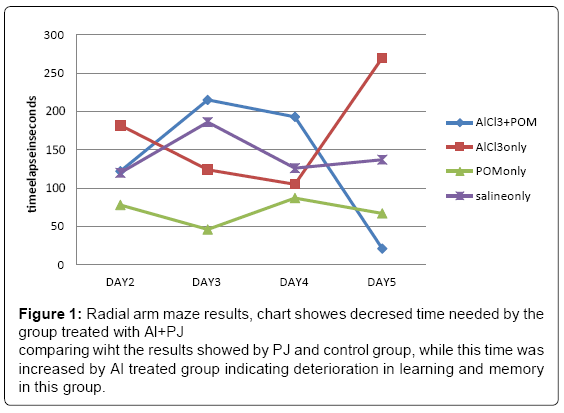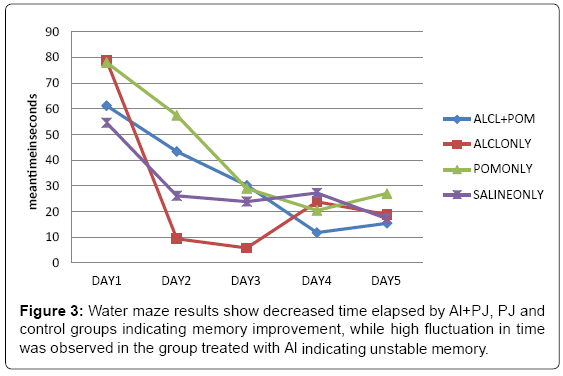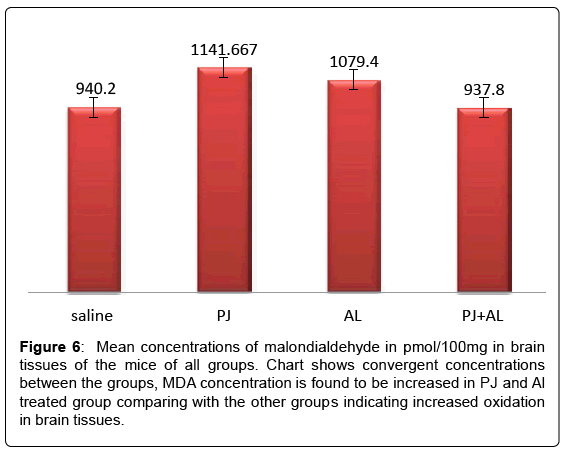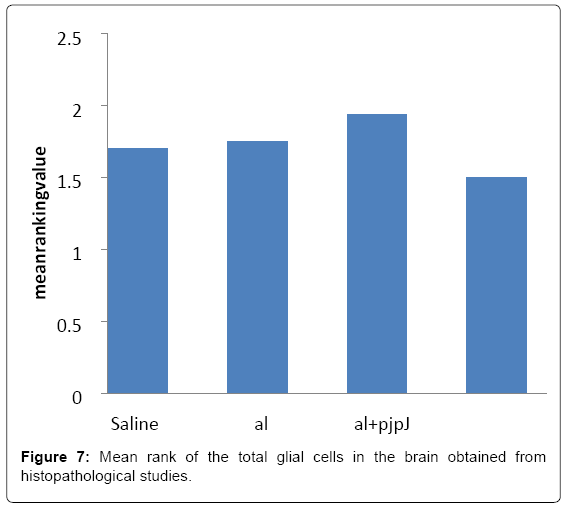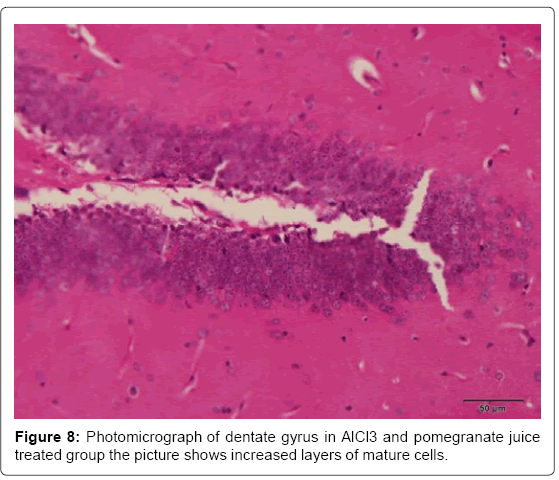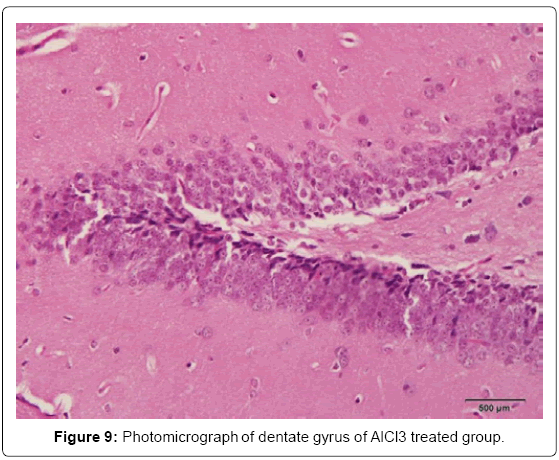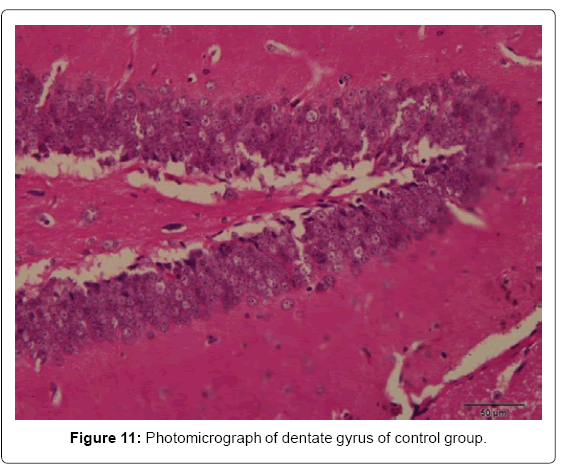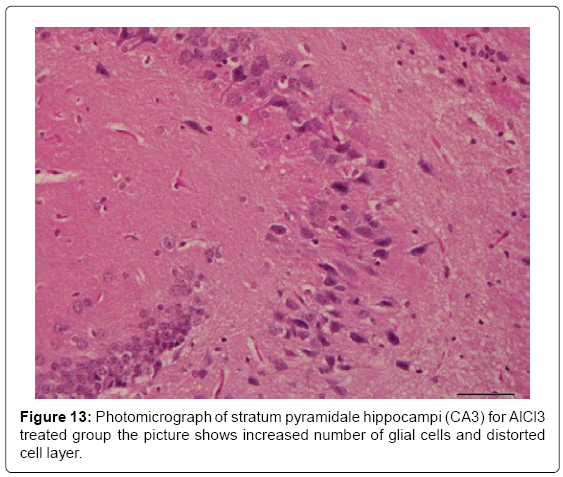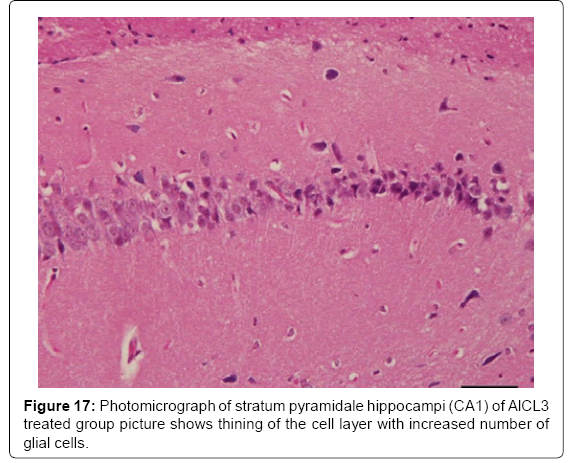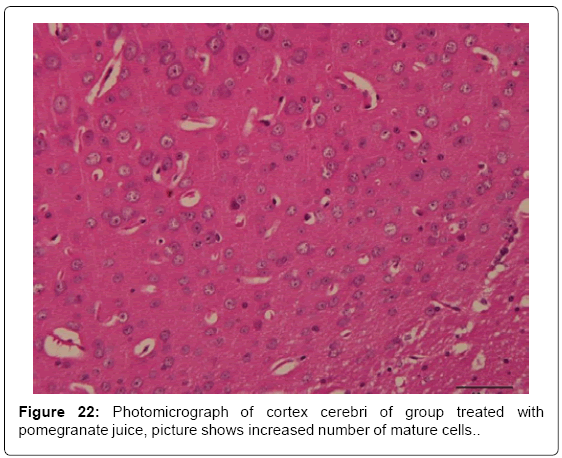Research Article Open Access
Possible Neuroprotective Role of Pomegranate Juice in Aluminum Chloride Induced Alzheimer's Like Disease in Mice
Sarah Abdulmalek*, Mansour Suliman and Osman Omer
Pharmacology department, King Abdulaziz University, Saudi Arabia
- Corresponding Author:
- Sarah Abdulmalek, Msc
Pharmacology department, King Abdulaziz University
Alrabwah district, Jeddah, Saudi Arabia
Tel: 96 656 996 5570
E-mail: s.aziz.malek@gmail.com
Received date: August 25, 2015; Accepted date: March 31, 2015; Published date: April 07, 2015
Citation: Abdulmalek S, Suliman M, Omer O (2015) Possible Neuroprotective Role of Pomegranate Juice in Aluminum Chloride Induced Alzheimer’s Like Disease in Mice. J Alzheimers Dis Parkinsonism 5:188. doi:10.4172/2161-0460.1000188
Copyright: © 2015 Abdulmalek S, et al. This is an open-access article distributed under the terms of the Creative Commons Attribution License, which permits unrestricted use, distribution, and reproduction in any medium, provided the original author and source are credited.
Visit for more related articles at Journal of Alzheimers Disease & Parkinsonism
Abstract
Alzheimer’s disease is the most common type of dementia. Impaired learning and loss of memory are the most common symptoms of the disease. In the present study Alzheimer’s disease was chemically induced using aluminum chloride intra-peritoneal injections in mice. Pomegranate juice was used to prevent the Alzheimer’s like symptoms. After the treatment period, behavioral studies were done in mice to assess learning and memory. Biochemical assays and histopathological studies were made to determine the effect of pomegranate at the cellular level. Treatment with pomegranate juice for 29 days was shown to improve learning and memory in mice. Histopathological studies showed that pomegranate juice has a protective effect on brain cells against aluminum chloride-induced degeneration. Biochemical results showed decreased concentration of glutathione in brain tissue and an increased concentration of malondialdehyde suggesting increased level of oxidation in the brain tissue. The present results show that, pomegranate juice has a neuroprotective effect against Alzheimer’s like disease induced by aluminum chloride. Ingestion of pomegranate juice improves learning and memory in rodents. Further studies are needed to clarify the exact mechanism of action of pomegranate in the brain tissue to determine the effect of pomegranate
Keywords
Alzheimer’s disease; Pomegranate; Behavioral studies; Antioxidants; Neuro-protection
Introduction
Alzheimer’s disease (AD) is the most common type of dementia. It causes severe suffering for the patients, in the form of progressive behavioral and neurological changes that include functional impairment, loss of independency, emotional problems and behavioral disturbances [1]. AD has several underlined causative factors and aluminum toxicity is one of these factors. Aluminum is a heavy metal that does not have a biological role in the body. In contrast, it affects body systems in a toxic way; it is believed to cause neuro-degeneration in human cell lines [2]. Aluminum is found in some cooking utensils, food preservatives, in drinking water and naturally in dietary products [3].
Recently, several studies have indicated that dietary intake of antioxidants lowers the risk of AD. Yet, more experiments are required to withdraw firm conclusions on the prophylactic effect of antioxidants [4]. In Saudi Arabia and other subtropical countries, pomegranate (Punicagrantum L.) is cultivated on a wide range. This fruit contains high levels of antioxidants mainly in the form of polyphenols. Polyphenols have been shown to be neuroprotective in different model systems [5].
This work aims to investigate the neuroprotective effect of pomegranate against damage caused by AlCl3 in mice brain. Evaluation will be done through behavioral assay, biochemical assay and histopathological assay.
Materials and Methods
Swiss male mice weighing between 30-40 g were used in this study. Animals were caged in groups of ten and allowed free access to food and water. Mice were allowed to acclimatize to the lab environment for one week before the experiment started. Temperature, humidity and 12 hours light and 12 hours dark cycle was maintained. Experiments were approved by the ethics committee
Aluminum chloride (AlCl3) was used to induce Alzheimer’s like disease in mice. Mice were injected AlCl3 40 mg/kg IP [6] daily for 29 days. Animals were grouped into four groups of ten mice each; group (1) Received AlCl3 40 mg/ kg (i.p.) for 29 days and allowed access to normal food and water. Mice of group (2) Received AlCl3 i.p. daily and allowed free access to pomegranate juice (pj) as drinking water and normal food. Mice of group (3) Received equivalent values of saline i.p. and allowed to access pomegranate juice instead of drinking water and normal food. Mice of group (4) Received equivalent values of saline and allowed access to normal food and water.
At the end of treatment period, mice underwent behavior study for five days to evaluate learning and memory status. At experiment termination, mice were sacrificed and brain tissues were collected. Each brain was divided into halves; right and left half hemisphere. One half was fixed and stored in 10% formaldehyde for histopathological studies. The second half was stored at -80°C for biochemical investigations.
Preparation of pomegranate juice
Pomegranate fruit were obtained from Al-Shafa in Taif, Saudi Arabia. The fresh fruit was peeled and seeds were collected, blended and filtered in ordinary sieve to obtain the juice. After that, juice was diluted in drinking water to form a concentration of 20% and served to the animals. As observed, each mouse consumed 5 ml of water per day. So, the dose of pomegranate served to the animals is 1 ml per day for each mouse. From a pilot study, 20% of pomegranate proved to affect behavioral skills in mice. So, 20% concentration was used in this study. Pomegranate juice in drinking bottles was changed on alternative day basis.
Radial armed maze
Radial arm maze is an important tool for studying spatial memory in animals. It was used as being described by Olton (1976) with slight modification to evaluate spatial memory deficit in mice [7].The maze used is 122 cm diameter. It consists of 8 chambers each chamber is 46 cm long from the center, 16.5 cm wide and its walls is 37.5 cm high (Figure 1). The inner arena is 31 cm diameter. Animals were overnight fasting before the test. At the beginning of the test each animal was released in the center of the maze facing the baited arm and was allowed to explore the maze freely in the first day; no records were registered. On the second, third and fourth days, mice are released in the center of the maze facing the baited arm and given a maximum six minutes to find the food. If one animal found the food before the end of time then the watch was stopped and elapsed time is recorded. Numbers of entry to the wrong arms and the right arm was also recorded for each day.
Active avoidance test
The method was described by Hirakawa[8]. It was used to evaluate memory and cognitive function in mice. The device manufactured by Lafayette instrument co. and is consists of power control and closed chamber. The power control used to generate a warning sound and electric shock of 1 MA. The chamber is cubic in shape with 16x16 cm floor and 20 cm high walls. The floor consists of metallic bars that conduct the electric shock. At the center a plastic pole is placed as tall as the walls of the chamber and is available for the mouse to climb it. Briefly, mice were placed in the chamber and allowing it to explore the area for one minute. After that, a warning sound was introduced for three seconds followed by an electric shock of 1 MA for 2 seconds. The mouse was allowed to rest for seven seconds before the next warning sound and a one-minute interval between every five sessions. In this study three parameters were registered; if the mouse did not escape the electric shock by climbing the pole, then it was recorded as none. If the mouse escaped the electric shock and climbed the pole, this was recorded as escape, and if the mouse avoided the electric shock by climbing the bole within the warning period, before warning sound is ceased, the term avoid is recorded. The test consisted of fifteen sessions for each mouse every day (Figure 2).
Water maze test
Water maze as being described by Morris [9] and modified by Whishaw and Bryan (1984) was used to evaluate spatial memory in rodents. A pool of 49 cm diameter was used in this test. The water was 23 cm deep. The platform was 10 cm diameter and is submerged by 1.5 cm under the water. The water temperature was similar to room temperature. Milk was added to the water to change the color of the water so the platform was invisible. The test was started by releasing the mouse in the middle of the pool and allowing it to swim for two minutes maximum time to find the hidden platform and stood on it for ten seconds, time elapsed to reach the platform is recorded (Figure 3). If the mouse spent the maximum time without finding the platform, it was guided to the platform and allowed to stand on it for ten seconds.
Head poking test
Method described by Pohorecky[10] was used to analyze learning curve in mice [10,11]. The arena was 44 X 44 cm and the walls were 20 cm high. The base consists of 16 holes each of 1.5 cm diameter. Mice were placed in the center of the arena and left to explore it freely. Each head poking was counted if the head was totally dipped in the hole with the eye disappearing in it. Two subsequent pokes were rare, but it was counted in the case of completely removing the head out of the hole and poking it again. The experiment duration was ten minutes for each mouse and the test was done only once (Figure 4).
Biochemical assay
Malondialdehyde ELISA kit: The kit was purchased from antibodies online web site (Schloss-Rahe-Str. 15, 52072 Aachen, Germany). The assay procedure was done according to the attached manual. Tissue samples were allowed to thaw before the test. Reagents, samples and standards were prepared and added to the plate and were incubated at 37°C for 90 minutes and plate washed twice with TBS. Antibodies were added and incubated at 37°C for 60 minutes and then the plate washed three times with TBS. after that the working solution were added to the plate and incubated at 37°C for 30 minutes and the plate washed five times with the TBS. The color developing reagent was added to the plate and incubated at 37°C until the color appeared. After that stop solution were added and the plate was read using optical density (O.D.) absorbance of 450 nm and MDA concentrations were calculated.
Glutathione ELISA kit: Frozen brain tissues were allowed to multiple thawing and freezing series before the assay to allow breaking of cell membrane for more précised results. Glutathione ELISA kit was obtained from antibodies online web site (Schloss-Rahe-Str. 15, 52072 Aachen, Germany) and the assay procedure was made according to the manual attached with the kit.
Standards and samples were added to appropriate well in the antibody pre-coated microtiter plate. Balance solution was added into the specimens and mixed well. After that, conjugate was added and the plate was covered and incubated for 1 hour at 37°C. Microtiter plate was washed five times with diluted wash solution. Then, substrates were added and the plate was covered and incubated for 10-15 minutes at 37°C. Stop solution was added and mixed and the optical density was determined at 450 nm using microplate reader.
Histopathological studies
Brain samples were sent to future lab (Al-Basateen district, Prince Sultan road, Arab national bank ANB building, Jeddah 21434, Saudi Arabia) for histopathological studies. Brain tissues were embedded in paraffin. Paraffin blocks were sectioned into 4-5 μm thick sections. Brain sections were stained in heamatoxyline and eosine (H and E) to be examined by light microscope.
Results
Radial arm maze
As the time needed to find the baited arm decreases, memory and learning is improved. Total time elapsed to reach the baited arm in the group of mice treated with saline (control) in four days was569 sec, on average of 142.25 ± 25.9 sec/day. In case of AlCl3 treated mice, the total time was 19.6% higher than that of the control with an average of 170.25 ± 64.19 sec/day. Mice treated with PJ showed 51.1% lower time than that of control group with an average of 69.5 ± 15.3 sec/day. Yet, co-administration of PJ and AlCl3 lowered the total time by 3.1% compared with control group and by 19% compared with AlCl3 treated mice but it still higher by 98.2% compared with PJ treated mice. A strong negative correlation was found between elapsed time and days, these were -0.93, and -0.97 in PJ and co-administration of PJ and AlCl3 group respectively. Control group showed 58% error while entering the chambers. This percentage was increased by 22% in the AlCl3 treated mice while it was the same percent in the group treated with co-administering PJ and AlCl3 (Table 1). The PJ treated group showed 13% increase comparing with control group (Figure 1).
| Day 2 (sec) | Day 3 (sec) | Day 4(sec) | Day 5 (sec) | p. value | |
|---|---|---|---|---|---|
| Saline (n=9) | 120±94.8 | 186±141.36 | 126±104.5 | 137±121.8 | |
| Al (n=5) | 182±96.46 | 124±70.68 | 105±32.55 | 270±151.2 | 0.26 |
| PJ (n=9) | 78±83 | 46±53.4 | 87±48.72 | 67±53.6 | 0.004 |
| Al+PJ (n=5) | 122±119.56 | 215±107.5 | 193±136.4 | 21±9.79 | 0.463 |
• Data were presented as mean ± standard deviation.
• Significant level from control was considered at p Ë? 0.05
Table 1: Average Time Elapsed in Sec/Day in the Radial Arm Maze Test.
Active avoidance test
Active avoidance test was used to evaluate the improvement in learning ability and memory in mice. As explained previously, the result of this test is expressed by either none; which means no reaction toward the shock, escape; which means escaping the shock by climbing the pole, and avoid; which means avoiding the shock right after the warning sound by climbing the pole. Generally, mice showed higher escape response than avoidance response. The ratio of avoidance to escape response through the five days trial were 0.5, 0.6, 0.3 and 0.7 for mice treated with saline, PJ, AlCl3 and AlCl3+PJ respectively. Avoidance and escape response were highly correlated with number of days with a correlation value that ranges between 0.82–0.93.
The total value of avoidance and escape for the mice treated with saline was 64 and 125 respectively. AlCl3 treated mice showed significant decrease in the avoidance response with P-value of 0.013 by 27.6%. Yet, it increases the escape response by 13.2%. Co-administration of PJ and AlCl3 significantly increased the avoidance response by 1.34 folds with a P-value of 0.007. This was significantly higher than that of control and PJ treated mice by 70% and 19% respectively. On the other hand, AlCl3 increases the escape response by 13% of that of control group (Table 2). Co- administration of PJ and AlCl3 elevates the escape response by 7% compared with AlCl3 treatment. This was slightly higher than that of PJ treated mice by 1.3% (Figure 2).
| SALINE (n=9) |
Al (n=5) |
PJ (n=9) |
AL+PJ (n=5) |
||
|---|---|---|---|---|---|
| Day 1 | None | 88% | 91 % | 81 % | 87% |
| Escape | 7% | 7.50 % | 14% | 10% | |
| Avoid | 5% | 1.50 % | 5 % | 3% | |
| Day 2 | None | 64% | 86 % | 60 % | 63% |
| Escape | 29% | 12 % | 29 % | 16% | |
| Avoid | 7% | 2 % | 11 % | 21% | |
| Day 3 | None | 59% | 57 % | 46 % | 46% |
| Escape | 30% | 35 % | 37 % | 33% | |
| Avoid | 11% | 8 % | 17 % | 21% | |
| Day 4 | None | 53% | 45 % | 39 % | 31% |
| Escape | 33% | 47 % | 33 % | 44% | |
| Avoid | 14% | 8 % | 17 % | 25% | |
| Day 5 | None | 47% | 33 % | 22 % | 12% |
| Escape | 26% | 40 % | 37 % | 49% | |
| Avoid | 27% | 27 % | 41 % | 39% | |
• Results were presented as percentage of active avoidance parameters compared to control.
Table 2: Percentage of the Active Avoidance Test Parameters.
Water maze test
Good learning skills and memory is inversely proportionate with the time needed until the platform is found. Starting with the control group, the five days total time needed to reach the platform was 148.9 sec. the time was declining from 54.5 sec in the first day to 17.2 sec in the fifth day with a declining rate of 7.4 sec/day. A negative correlation was found between time and days that equals to -0.89. The PJ treated group showed 41% increase in that total time compared with the control group. The time declining rate for PJ treated group was 10.2 sec/day. Mice treated with AlCl3 showed slightly lower total time than that of control group with 8.2%. The declining rate for this group was slightly higher than that of the control group with 12 sec/day. In the first day, the groups showed relative increased time until the platform was reached. The control group showed the lowest time while the AlCl3 treated group showed the highest time. In the second day, all groups showed a decrease in the time needed to reach the platform especially the AlCl3 treated group which showed the lowest time. In the third day, groups showed decrease in time but the group treated with AlCl3 also showed the lowest time. In the fourth day, the group treated with AlCl3 and pomegranate juice and the group treated with pomegranate juice showed continued decline in the time needed to reach the platform. Yet, regarding the two other groups, an increase in the time was found. However, AlCl3 and pomegranate juice treated group showed the lowest consumed time (Figure 3).
In the fifth day, AlCl3 treated group and the control group showed decline in the time whilst the pomegranate treated group and AlCl3 and pomegranate juice treated group showed slight increase in the consumed time. In spite of this, the group treated with AlCl3 and pomegranate juice showed the lowest consumed time (Table 3).
| Day 1 (sec) | Day 2 (sec) | Day 3 (sec) | Day 4 (sec) | Day 5 (sec) | |
|---|---|---|---|---|---|
| SALINE (n=9) | 54.5±40.4 | 26.11±38.7 | 23.9±26.2 | 27.2±22.9 | 17.2±13.2 |
| Al (n=5) | 78.8±41.6 | 9.4±7.5 | 5.8±2.8 | 23.8±18.8 | 18.8±13.2 |
| PJ (n=9) | 78±43.6 | 57.4±32.4 | 29±21.5 | 20.4±35.2 | 27±23.8 |
| Al+PJ (n=5) | 61.2±42.9 | 43.4±44.2 | 30.2±44.9 | 11.8±5.1 | 15.4±9.5 |
• Data were presented as mean ± standard deviation.
• Significance from the control group was considered at p-value < 0.05.
Table 3: Time Elapsed in Seconds Until Reaching the Platform in The Water Maze Test.
Head poking test
Increased number of head pokes indicates increased curiosity and decreased anxiety. Mice of the control group gave 71 pokes per 15 min. PJ increased the head poking by 11.25%. Mice treated with AlCl3 showed 18.75% and 8.5% decrease compared with that of PJ and control mice respectively. Co-administration of PJ and AlCl3 slightly lowered the poking number compared with AlCl3 treated mice. Yet, administration of AlCL3 and PJ lowered the poking value by 38.75% and 31.99% compared to that of PJ and saline treated mice (Figure 4).
Glutathione concentration (GSH)
After calculating the mean concentration of each group, the results showed higher concentration of the glutathione in the control group compared to that of AlCl3, PJ and group treated with co-administration of AlCl3 and PJ. No correlation was found between these results and the result obtained from the behavior studies (Figure 5).
Malondialdehyde concentration (MDA)
After calculation of mean concentration for each group, it was found that there was no notable difference in the concentrations of Malondialdehyde between the groups. No correlation was found between this result and results obtained from the behavior studies (Figure 6).
Figure 6: Mean concentrations of malondialdehyde in pmol/100mg in brain tissues of the mice of all groups. Chart shows convergent concentrations between the groups, MDA concentration is found to be increased in PJ and Al treated group comparing with the other groups indicating increased oxidation in brain tissues.
Histopathological assay
Comparing groups revealed decrease cell density in the dentate gyrus of the AlCl3 treated group. Cell density is almost the same for the other groups. Cell layer distortion is found in (CA3) area of the AlCl3 treated group while intact cells were observed for the other groups. Regarding the AlCl3 treated group, glial cells with low cell layer density was observed. Yet, an increased cell layer density was observed in group treated with co-administration of AlCl3 and pomegranate juice. There was found an increased number of glial cells in the cortex of the AlCl3 treated group more than that found in the other groups (Figures 7-23).
Discussion
In general, mice treated with aluminum showed impairment in their spatial memory. Co-administration of AlCl3 and PJ revert some of aluminum effects on memory. In the present work, aluminum significantly increased the time required to reach the baited arm and increased the errors compared with that of control (saline treated mice) indicating memory impairment which was consistent with the results obtained by [12], who found that aluminum intoxication caused increase in the period of time needed to finish a trial [12]. Percentage of entry errors was increased by mice treated with AlCl3. Errors of entry were decreased in the group treated with co-administering AlCl3 and PJ by 22%. This result showed that PJ has a protective effect against aluminum induced learning and memory deficit. Results obtained from water maze test showed consistent decrease in the time required to find the platform. The aluminum treated mice showed high fluctuation in the time required to reach the platform from one day to another. The declining rate of the time needed to reach the platform was relatively steady for the control, PJ and group treated with AlCl3 and PJ. The control group required 17.2 seconds to find the hidden platform in the last day while group treated with AlCl3 and PJ showed lower time (15.4 sec) compared with that of the control and AlCl3 treated group (18.8 sec). These results lead us to estimate that PJ may exert its effect by regulating the decreasing rate of time. The fluctuation in the time required to find the platform showed by AlCl3 treated mice was decreased by the ingestion of PJ.
Suggesting that, although the effect of PJ was not revealed by monitoring the time needed to find the platform, yet, it was showed that PJ effect was contributed to the declining rate in the time and reverting the fluctuation caused by AlCl3. Regarding active avoidance test an increase in the avoidance response was generally found among the mice of all groups and was highly correlated with time. Yet, the total value of the avoidance response was found to be significantly decreased by the AlCl3 treated group compared with that of the control group. This value was significantly increased by the group treated with AlCl3 and PJ compared also with the control group. This result was consistent with results obtained by Sarkaki and others (2013) who found that pomegranate seeds extract increased the active avoidance memory in rats after induced cerebral ischemia [13]. A high correlation was found between the radial maze test and the avoidance response in PJ and AlCl3 and PJ groups. On the other hand, higher correlations were found between errors in the radial maze and avoidance response among the groups. These correlations indicate that both radial arm maze and active avoidance test may evaluate memory processing in a specific region of mice brain. Our findings from head poking test suggest that PJ possess an anxiolytic effect and increase the curiosity. This was showed by increased number of head poking in the PJ treated group which was 80 pokes per 15 min. Comparing with PJ, AlCl3 showed 65 pokes while the control group showed 71 poke per 15 minutes. Yet, the group treated with PJ and AlCl3 showed 49 pokes per 15 minutes which was the lowest head pokes showed by the groups. Kumar[14] found that ethanolic extract of pomegranate was associated with decreased anxiety in mice. Biochemical assay showed relatively high oxidation in brain tissue suggesting that PJ does not prevent oxidative damage of the brain tissue. However, it has been shown that natural antioxidants do not penetrate the blood-brain barrier [15] this may be due to their large structure and water solubility that prevents them from crossing the blood brain barrier. Results obtained from histopathological assay suggest that PJ possess neuroprotective effect against aluminum toxicity represented by decreased number of glial cells and intact cell layer in specific hippocampal regions.
Conclusion
Pomegranate juice was found to be neuroprotective against aluminum induced toxicity. Improved learning and memory was related to ingestion of pomegranate juice in mice. The exact mechanism is unclear since the antioxidant activity of pomegranate juice was not detected in brain tissue. Pomegranate juice may be of great importance in treating Alzheimer’s disease neurotoxicity and improving related symptoms in human.
Acknowledgements
I would like to thank King Abdulaziz University and pharmacology department for supporting me to accomplish the research by fund of 14,900 S.R. I also want to thank Amal Almustady and Wedian Hijazi for being so supportive and helping me to overcome difficulties during the research period. And I also thank Mr. Zaki Al-Asouli for helping me in this research. I would like to direct my thankfulness to HanaaKhalaf and Bayan Shuaib the lab technicians for their unconditioned assistance.
References
- Williams J W, Plassman BL, Burke J, Holsinger T, Benjamin S (2010) Preventing Alzheimer's disease and cognitive decline.
- Campbell A, Hamai D, Bondy C (2001) Differential toxicity of aluminum salts in human cell lines of neural origin: implications for neurodegeneration. Neurotoxicology 22: 63-71.
- Schaefer U, Seifert M (2006) Oral intake of aluminum from foodstuffs, food additives, food packaging, cookware and pharmaceutical preparations with respect to dietary regulations, Public Health, Australia.
- Rutten BP, Steinbusch HW, Korr H, Schmitz C (2002) Antioxidants and Alzheimer's disease: from bench to bedside (and back again). CurrOpinClinNutrMetab Care 5: 645-651.
- Hartman RE, Shah A, Fagan AM, Schwetye KE, Parsadanian M, et al. (2006) Pomegranate juice decreases amyloid load and improves behavior in a mouse model of Alzheimer's disease. Neurobiol Dis 24: 506-515.
- Shati AA, Elsaid FG, Hafez EE (2011) Biochemical and molecular aspects of aluminium chloride-induced neurotoxicity in mice and the protective role of Crocus sativus L. extraction and honey syrup. Neuroscience 175: 66-74.
- Tarragon E, Lopez L, Ros-Bernal F, Yuste J, Ortiz-Cullera V, et al. (2012) The radial arm maze (RAM) for the evaluation of working and reference memory deficits in the diurnal rodent octodondegus, proceeding in measuring behavior.
- Hirakawa M, Tamura A, Nagashima H, Nakayama H, Sano K (1994) Disturbance of retention of memory after focal cerebral ischemia in rats. Stroke 25: 2471-2475.
- Morris R (1984) Developments of a water-maze procedure for studying spatial learning in the rat. Journal of neuroscience methods 11: 47-60.
- Pohorecky LA (1976) Withdrawal from ethanol: simple quantitative behavioral tests for its evaluation. Psychopharmacology (Berl) 50: 125-129.
- Papachristos EB, Gallistel CR (2006) Autoshaped head poking in the mouse: a quantitative analysis of the learning curve. J Exp Anal Behav 85: 293-308.
- Struys-Ponsar C, Kerkhofs A, Gauthier A, Soffié M, van den Bosch de Aguilar P (1997) Effects of aluminum exposure on behavioral parameters in the rat. Pharmacol Biochem Behav 56: 643-648.
- Sarkaki A, Rezaiei M, Naseri MG, Rad M R (2013) Improving Active and Passive Avoidance Memories Deficits Due to Permanent Cerebral Ischemia by Pomegranate Seed Extract in Female Rat. Malaysian Journal of Medical Sciences 20: 25-34.
- Kumar S, Maheshwari KK, Singh V (2008) Central nervous system activity of acute administration of ethanol extract of Punicagranatum L. seeds in mice. Indian J Exp Biol 46: 811-816.
- Halliwell B (2001) Role of free radicals in the neurodegenerative diseases: therapeutic implications for antioxidant treatment. Drugs Aging 18: 685-716.
Relevant Topics
- Advanced Parkinson Treatment
- Advances in Alzheimers Therapy
- Alzheimers Medicine
- Alzheimers Products & Market Analysis
- Alzheimers Symptoms
- Degenerative Disorders
- Diagnostic Alzheimer
- Parkinson
- Parkinsonism Diagnosis
- Parkinsonism Gene Therapy
- Parkinsonism Stages and Treatment
- Stem cell Treatment Parkinson
Recommended Journals
Article Tools
Article Usage
- Total views: 18789
- [From(publication date):
March-2015 - Apr 02, 2025] - Breakdown by view type
- HTML page views : 13963
- PDF downloads : 4826

